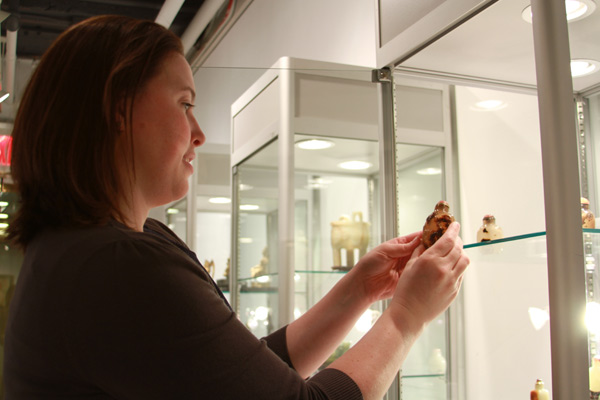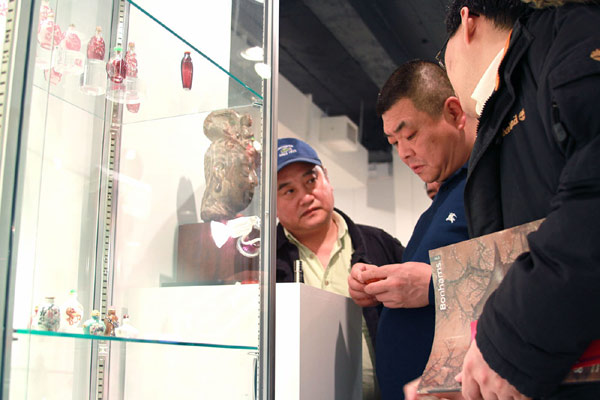
 'Taken 2' grabs movie box office crown
'Taken 2' grabs movie box office crown
 Rihanna's 'Diamonds' tops UK pop chart
Rihanna's 'Diamonds' tops UK pop chart
 Fans get look at vintage Rolling Stones
Fans get look at vintage Rolling Stones
 Celebrities attend Power of Women event
Celebrities attend Power of Women event
 Ang Lee breaks 'every rule' to make unlikely new Life of Pi film
Ang Lee breaks 'every rule' to make unlikely new Life of Pi film
 Rihanna almost thrown out of nightclub
Rihanna almost thrown out of nightclub
 'Dark Knight' wins weekend box office
'Dark Knight' wins weekend box office
 'Total Recall' stars gather in Beverly Hills
'Total Recall' stars gather in Beverly Hills
Snuff and stuff
Updated: 2013-04-01 05:47
By Derek Bosko (China Daily)
|
||||||||
|
 A visitor inspects an antique snuff bottle at Jadestone's From Curiosity to Devotion sales exhibit in New York. Photos by Derek Bosko / China Daily |
A recent exhibition of ancient artifacts spans the secular and the sacred, ranging from the frivolous to the serious. Derek Bosko reports in New York.
Alate-Shang Dynasty (c. 16th century-11th century BC) bronze tripod jue gets passed down by generations of an American family, losing two of its legs, as well as the awe it once inspired, only to find its way on a plane back to China, legs in tow and reattached.
"People don't realize they have a 3,000-year-old Chinese bronze vessel that they are using as a door stop or a dog's water bowl," says Erick Schiess, owner of Jadestone Fine Asian Art, Appraisal & Consulting LLC, a Portland, Oregon-based dealer of Asian art.
Jadestone exhibited in New York during Asia Week, March 15-23, which was a celebration of Asian art by museums, auction houses and cultural institutions.
Jadestone's sales exhibit From Curiosity to Devotion featured Chinese art and artifacts, including Buddhist statuettes, snuff bottles and hand-carved jade objects. Schiess says almost all of them came from early US collections, with a few snuff bottles from a Portuguese collector.
"The majority of the pieces were sold to buyers from the Chinese mainland and are being returned to Chinese collections and Chinese dealers," Schiess says.
About 80 percent of Schiess' clients are from Beijing, Shanghai, and Xi'an, and some are from Hong Kong and Taiwan. He also has Chinese-American clients in New York and some internationally based American and European clients.
The link among the artifacts on display is reflected in the double meaning of the exhibition's title.
Many of the secular pieces, such as snuff bottles, were often referred to as "curios", and the sacred Buddhist and Taoist artworks were classified as "devotional".
When it comes to taste, there seems to be a large disconnect between the Western and Chinese buyer.
"Western buyers are not picky about the color of the jade or its purity, and American collectors are often attracted to the diversity of jade colors and the carvings," Schiess says.
Chinese buyers "desire purity in jade as it is perceived as perfection, evenness in color, often white or yellow jade", he says.
Buyers at the exhibit from Beijing were mostly preoccupied with jade objects or snuff bottles.
"Most Chinese buyers, with the exception of those interested in archaic bronze, are paying top dollar for Ming and Qing dynasty items from the 14th century to the early 20th century," Schiess says.
"Qianlong items are super-popular and important."
Snuff bottles occupied a large portion of the exhibit, with prices from $1,000 to $50,000.
Snuff, a powdered form of tobacco that's snorted, originally came from the Americas and spread throughout Europe, eventually making its way to China around the 17th century. Chinese nobility exclusively used snuff, and the craftsmanship of older snuff bottles is intricate and artistic.
Snuff became more accessible to other classes in China during the late 19th century, and the bottles' craftsmanship declined, Schiess says.
Snuff bottles, often made of porcelain or glass and sealed with a cork, are not to be confused with European snuffboxes that open on a hinge and lack portability.
Appraising Chinese art has gotten trickier due to fast-rising prices and the proliferation of counterfeits.
Schiess, who studied Asian art history, Chinese language and business at the University of Oregon and later went to Pratt Institute in New York to study art appraisal, says he has been going to auctions since he was 5 years old.
"In the past, forgeries were easy to spot because they were based of photos and the weight and texture would be wrong," Schiess says.
Now, art fabrication in China is done with the highest level of craftsmanship, and fake pieces are fed into legitimate collections to fool buyers, he says.
While many collectors may go to Sotheby's or Christie's, Schiess says that his gallery offers a personal touch not found at big auction houses.
"I sit down with my clients, we have a cup of tea and do research together," he says. "I guarantee all of the items I sell, and there is no pressure."
He says many of his clients are close friends and he often represents them at auctions.
The only problem Schiess has with his Chinese clients is their impatience.
"Chinese buyers, unlike Western buyers, don't like when you just put a red dot", meaning the item has been sold, Schiess says. "They want to wrap it up and take it back to China."
Contact the writer at dbosko@chinadailyusa.com.
|
 Chinese buyers are particularly interested in the jade objects and snuff bottles at From Curiosity to Devotion. |
(China Daily 04/01/2013 page20)
Most Viewed
Editor's Picks

|

|

|

|

|

|
Today's Top News
Boston bombing suspect reported cornered on boat
7.0-magnitude quake hits Sichuan
Cross-talk artist helps to spread the word
'Green' awareness levels drop in Beijing
Palace Museum spruces up
First couple on Time's list of most influential
H7N9 flu transmission studied
Trading channels 'need to broaden'
US Weekly

|

|







